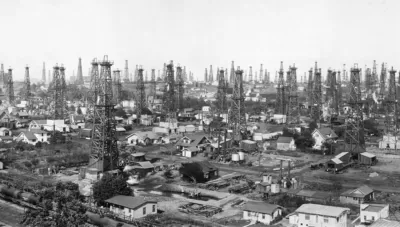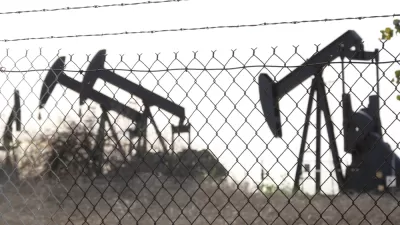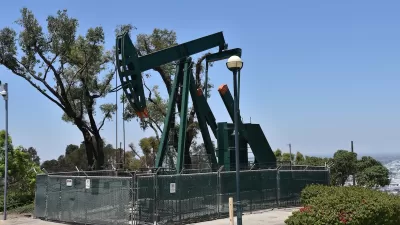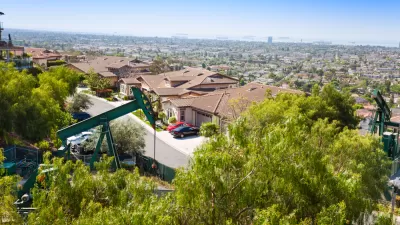Much of California's oil and gas extraction takes place in residential neighborhoods, posing significant health risks to entire communities.

"Every year, upward of 140 million barrels of oil are extracted from the state of California," writes Judith Lewis Mernit for Yale Environment 360. But "unlike more rural oil-producing states, where oilfields might be uninhabited but for the people who work on them, drilling in California happens to a large degree in residential settings."
"In Signal Hill to the south near Long Beach, drilling rigs butt up against playgrounds," while a wall obscures an active oil well just behind the Beverly Center, a posh mall in Los Angeles. "In addition to drilling operations, refineries in the Los Angeles and San Francisco Bay areas, handle some of the dirtiest oil in the world, from Alberta’s Athabasca oil sands to the state’s own carbon-heavy crude," writes Mernit. According to a 2020 analysis by FracTracker Alliance, over 7 million Californians live within a mile of an oil or gas well.
Despite "a mountain of evidence saying that living close to oil and gas wells is harmful to human health," between 2015 and 2020 California "issued more than 25,000 permits for drilling new wells and redrilling older ones, more than 60 percent of them in Spanish-speaking communities." But with "plenty of other culprits for polluted air," the connection is often difficult to prove. A surprising absence of data on the subject "makes it easier for petroleum’s boosters in the state to claim that oil activity does not pose a health hazard for nearby communities, and harder for legislators to protect their constituents from what they insist is making them sick."
Although "Oil industry advocates contend that California has the toughest environmental laws for petroleum extraction in the world," spotty enforcement, low fines, and exemptions for small producers—"the ones in neighborhoods, in people’s backyards"–have led to an unchecked proliferation of wells in residential areas and farms.
In recent years, cities around the country have taken steps to mitigate the impacts of urban oil drilling and limit new wells near homes and schools. "In 2013, the Dallas City Council passed an ordinance prohibiting new drilling within 1,500 feet of sensitive developments," while "[i]n Los Angeles, site of the country’s largest urban oil field, the city council is considering an ordinance to outlaw oil drilling within the city completely." But with oil companies lobbying to block such legislation, advocacy groups express cautious optimism for incremental victories.
FULL STORY: The Oil Well Next Door: California’s Silent Health Hazard

Alabama: Trump Terminates Settlements for Black Communities Harmed By Raw Sewage
Trump deemed the landmark civil rights agreement “illegal DEI and environmental justice policy.”

Study: Maui’s Plan to Convert Vacation Rentals to Long-Term Housing Could Cause Nearly $1 Billion Economic Loss
The plan would reduce visitor accommodation by 25% resulting in 1,900 jobs lost.

Why Should We Subsidize Public Transportation?
Many public transit agencies face financial stress due to rising costs, declining fare revenue, and declining subsidies. Transit advocates must provide a strong business case for increasing public transit funding.

Wind Energy on the Rise Despite Federal Policy Reversal
The Trump administration is revoking federal support for renewable energy, but demand for new projects continues unabated.

Passengers Flock to Caltrain After Electrification
The new electric trains are running faster and more reliably, leading to strong ridership growth on the Bay Area rail system.

Texas Churches Rally Behind ‘Yes in God’s Back Yard’ Legislation
Religious leaders want the state to reduce zoning regulations to streamline leasing church-owned land to housing developers.
Urban Design for Planners 1: Software Tools
This six-course series explores essential urban design concepts using open source software and equips planners with the tools they need to participate fully in the urban design process.
Planning for Universal Design
Learn the tools for implementing Universal Design in planning regulations.
Caltrans
Smith Gee Studio
Institute for Housing and Urban Development Studies (IHS)
City of Grandview
Harvard GSD Executive Education
Toledo-Lucas County Plan Commissions
Salt Lake City
NYU Wagner Graduate School of Public Service





























